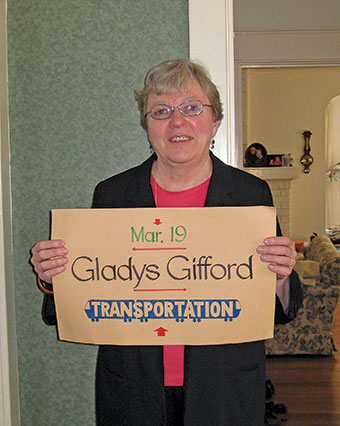Gladys Gifford: Public Transit Advocate

Get to know a Buffalonian...
Gladys Gifford: Public Transit Advocate
The NFTA recently held a public meeting on the proposed plan to return vehicle traffic to the 600 block of Main Street (between Tupper and Chippewa). The complicated plan would allow Metro Rail trains and cars to share the same roadway, with the hope of increased patronage to Theater District businesses. However, the plan has met some resistance from the Citizens for Regional Transit (citizenstransit.org), a local grassroots organization dedicated to promoting expansion of public transit. We spoke with CRTC President Glady Gifford about the plan and other mass transit issues in Western New York.
What are the biggest concerns the CRTC has with the plan to return traffic to the 600 block of Main St.?
Citizens for Regional Transit is concerned about two major issues: removing the Theater Station and allowing vehicles to drive on the rails (share the roadway with Metro Rail). The Theater Station serves about 2000 riders daily, including a large portion of the theater-going public. Elimination of the station will reduce transit service for those riders, especially transit-dependent riders, restricting the mobility of people who cannot afford to drive or choose not to drive. The current design allows motor vehicles to drive on the tracks. In the 600 block, this amounts to a short distance before traffic has to turn on Chippewa Street. Mixing cars and trains interferes with each mode, reducing efficient travel for both cars and trains. However, the main concerns are safety and reliability. Vehicles on the tracks will stall, break down, even collide with trains. When a collision occurs, who assumes liability? When any disruption occurs, the whole transit system is affected since bus lines feed into the light rail line. Reliability of the whole NFTA system is then compromised, with bus connections missed and time schedules upset.
In retrospect, does it seem like poor planning to limit a primary business street to pedestrian traffic in a cold weather/depressed city?
The pedestrian/transit mall could have been a boon to downtown Buffalo, but retail had already left for the suburbs by the time the mall opened. Currently, there is plenty of pedestrian activity during the lunch hour, when office workers enjoy the mall.
As it stands currently, what are the most deficient aspects of the public transit system in Buffalo?
The public transit system in metro Buffalo works well, considering the fiscal constraints placed on every public transit system in America. Metro Rail carries thousands of riders daily, and several bus lines are running at capacity. The main deficiency is that the Metro Rail portion ought to be extended to the suburbs in order to take advantage of its light rail capacity.
Where are the most likely corridors for expansion of the NFTA Metro Rail? How do you see expansion impacting these new areas reached?
The original plan was for Metro Rail to be extended in four directions: to the Tonawandas, to UB North campus, to the Buffalo Niagara International Airport in Cheektowaga, and to the Southtowns at least as far as the football stadium. When done with careful planning, economic benefits will cluster around the stations along each route-- a concept known as “transit oriented development.”
Are you concerned with the challenges of investing in expensive public transit works in a shrinking, increasingly sprawling city with a history of graft and squandering public money?
Millions of dollars are invested in metro Buffalo every year, through the region’s transportation planning organization, the Greater Buffalo Niagara Regional Transportation Council. Effective citizen and stakeholder input will ensure that these funds are spent wisely.
bonus: How often do you ride public transportation in Western New York? Do you commute to work?
As a retiree involved in volunteer work, I take Metro Rail frequently in order to reach downtown Buffalo. CRT holds its monthly meetings in downtown Buffalo.
bonus: What are some of the more successful mid-size city models out there Buffalo could hope to emulate?
San Jose, California; Portland, Oregon; Tempe, Arizona; Salt Lake City, Utah
bonus: Do you believe suburban dwellers stigmatize bus transport in ways they wouldn’t a metro system? Why do you think light rail is once again a fashionable solution to transit issues?
Commuters know very well that a Metro Bus will travel in the same traffic which snarls their daily route, so there is no time advantage to taking the bus. Furthermore, workers in downtown Buffalo are assured of parking spaces when they use their car. However, an expanded Metro Rail line would be built on existing railroad rights-of-way that will allow the train to reach speeds of 60+ mph separate from highways, thereby providing a quick and efficient route to work. The analysis of the Metro Rail system commissioned by the NFTA in 2001 stated that expanding Metro Rail to the airport would double ridership without doubling costs of operating and maintaining the system. Additionally, Metro Rail receives its electric energy from hydropower. Given future trends toward “green” infrastructure, now is the time for metro Buffalo to capitalize on Metro Rail as an asset to be expanded.
blog comments powered by Disqus|
Issue Navigation> Issue Index > v10n21 (Week of Thursday, May 26) > Gladys Gifford: Public Transit Advocate This Week's Issue • Artvoice Daily • Artvoice TV • Events Calendar • Classifieds |









 Current Issue
Current Issue